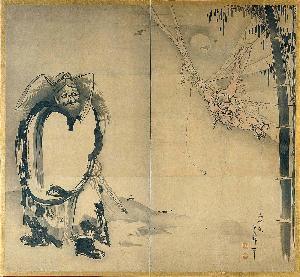Soga Shohaku
Soga Shohaku;Soga Shōhaku
Place: Ise Or Kyōto
Born: 1730
Death: 1781
Biography:
Life and Artistic Style
Soga Shōhaku, a Japanese painter from the Edo period (1730-1781), defied conventions with his unique brush style, reminiscent of the Muromachi period, which was already 150 years out of vogue by the time of his birth. This distinctive approach set him apart from his contemporaries.
Notable Works and Their Significance
* Race at Uji River (Harvard Art Museums, Cambridge, United States): This polychromatic screen, depicting a famous episode from the 14th-century war epic "The Tale of the Heike," showcases Shōhaku's pictorial grotesquerie. It is a rare example of his work in full color. * The Immortal Li Tieguai (128 x 28 cm, Paper): This piece illustrates the story of one of the eight Chinese immortals, Li Tieguai, and demonstrates Shōhaku's ability to convey complex narratives through his art.
Artistic Influences and Legacy
* Shōhaku's preference for the Muromachi period's brush style reflects an aesthetic that was already passé by the time of his birth. This choice not only distinguishes him from his contemporaries but also highlights his unique artistic vision. * His monstrous depictions of prominent figures were extremely unusual compared to other painters of his time, further solidifying his position as an unconventional artist.
Explore More at Wikioo.org
- Discover Soga Shōhaku's works in the Artist Profile on Wikioo.org.
- Learn more about Japanese art movements, including The Bunjinga Art Movement, which influenced Shōhaku's style.
- View other notable artists from the Edo period in Wikioo.org's extensive collection, including Mori Ransai.
Conclusion
Soga Shōhaku's unorthodox approach to Japanese painting during the Edo period has left an indelible mark on art history. His unique style, characterized by monstrous depictions and a preference for outdated aesthetics, continues to fascinate art lovers today. Explore his works and those of other influential artists at Wikioo.org, the Virtual Museum for Art Aficionados. References:
- Soga Shōhaku - Artist Profile, Wikioo.org
- The Bunjinga Art Movement, Wikioo.org
- Mori Ransai - Artist Profile, Wikioo.org
- Ito Jakuchu, known for his unique use of vegetables and plants in his art.
- Kano Einō, a prominent member of the preeminent Kano family workshop.











